 |
 |
 |
| |
Low Screening Rates for HBV, HCV, and Diabetes in NYC HIV Cohort
|
| |
| |
"Fewer than half of MMP participants were screened for any one of the comorbid conditions"
from Jules: of note 49% of study population were 50 years old or more, 51% Black & 37% Hispanic, yet the odds ratio of big screened was 0.36 compared to younger 18-34 age group.
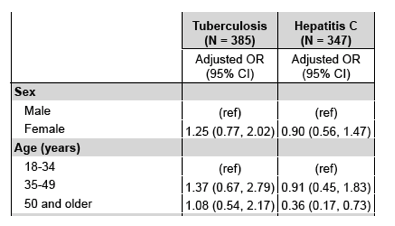
IDWeek 2017/IDSA, October 4-8, 2017, San Diego
Mark Mascolini
In a demographically representative sample of New York City residents in care for HIV, one quarter or fewer got screened in the past year for hepatitis B or C (HBV, HCV), while only one third got screened for diabetes [1]. Compared with blacks, whites had a 70% lower chance of getting tested for diabetes.
Non-HIV chronic illnesses, especially age-related conditions, account for a growing burden of morbidity and mortality in many HIV populations. Screening guidelines for major illnesses in people with HIV are available and regularly updated. But New York City Department of Health and Mental Hygiene researchers who conducted the new study noted that screening rates "may not correspond with risk factor status."
The Department of Health team aimed to assess screening for tuberculosis, HBV, HCV, type 2 diabetes, and three sexually transmitted infections--syphilis, chlamydia, and gonorrhea. They determined screening rates for people in the 2012 cycle of the New York City Medical Monitoring Project, a CDC collaboration that assembles and interviews demographically representative populations in care for HIV across the country. This analysis involved people 18 and older who had an HIV care visit between January 1, 2012 and April 30, 2012. The researchers collected screening data by medical record abstraction.
Current HIV guidelines [2,3] set the following screening frequencies for TB (at HIV diagnosis then annually for those at high risk), HBV (when HIV care begins), HCV (when HIV care begins then annually for those at high risk), chlamydia, gonorrhea, and syphilis (at least annually for sexually active people, every 3 to 6 months for those with certain risk factors), diabetes (before and within 3 months of starting antiretroviral therapy). This analysis considered screening histories over the 12 months preceding the Medical Monitoring Project interview. The researchers did not assess HBV screening rates for people with a record of chronic HBV or HBV vaccination. They used logistic regression to determine adjusted odds for factors associated with screening.
The study group included 439 adults, 62% of them men, 49% 50 or older, 51% black, 37% Hispanic, and 10% white. Two thirds of the group (64%) made 3 or more office visits in the past year that included a viral load assay or CD4 count, while the rest had 0 to 2 visits; 34% reported any sexual risk behavior, and 22% had a history of injecting drugs.
Overall, fewer than half of participants got screened for any one of the target conditions in the past year. Screening frequencies in the past year were 42% for TB, 46% for syphilis, 41% for chlamydia, and 38% for gonorrhea. Only 37% got screened for diabetes in the past year, 26% for HCV, and 18% for HBV.
Logistic regression analysis determined that people with at least 3 medical visits in the past year had more than 3-fold higher odds of getting screened for an STI (adjusted odds ratio [aOR] 3.84) or for HCV (aOR 3.54). Whites were 70% less likely than blacks to get tested for diabetes (aOR 0.30), and Hispanics were 70% more likely than blacks to get screened for HCV (aOR 1.72). Age, sex, drug-injecting history, and sexual risk behavior did not affect chances of screening for any illness.
The researchers suggested that variable screening rates for the target illnesses "may point to a need for improved integration of HIV care with other clinical services and/or improved communication between patients and providers regarding risk." They encouraged HIV providers to assess comorbidity risk factors regularly.
References
1. Lazar R, Kersanske L, Braunstein S. Screening for comorbid conditions among people with HIV in medical care. IDWeek2017/IDSA. October 4-8, 2017. San Diego. Abstract 561.
2. Panel on Opportunistic Infections in HIV-Infected Adults and Adolescents. Guidelines for the prevention and treatment of opportunistic infections in HIV-infected adults and adolescents: recommendations from the Centers for Disease Control and Prevention, the National Institutes of Health, and the HIV Medicine Association of the Infectious Diseases Society of America. http://aidsinfo.nih.gov/contentfiles/lvguidelines/adult_oi.pdf. Accessed on 12/1/2015
3. Aberg JA, Gallant JE, Ghanem KG, et al. Primary care guidelines for the management of persons infected with HIV: 2013 update by the HIV Medicine Association of the Infectious Diseases Society of America. Clin Infect Dis. 2014;58:1-10.
----------------------------------
Screening for comorbid conditions among people with HIV in medical care
Rachael Lazar1, Laura Kersanske2, Sarah L. Braunstein1
1New York City Department of Health and Mental Hygiene 2Massachusetts Department of Health

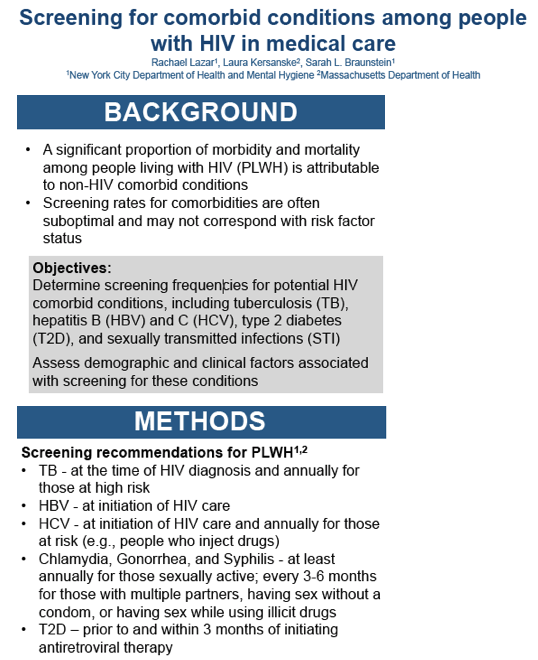
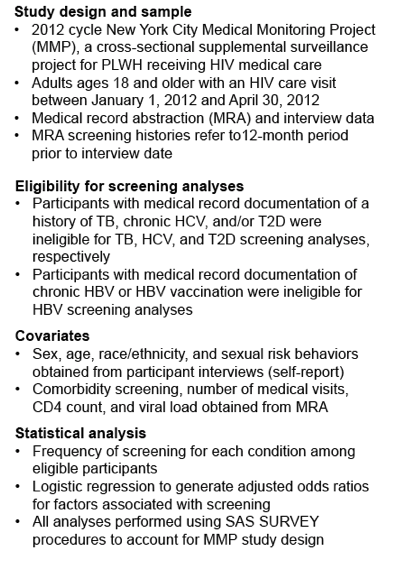
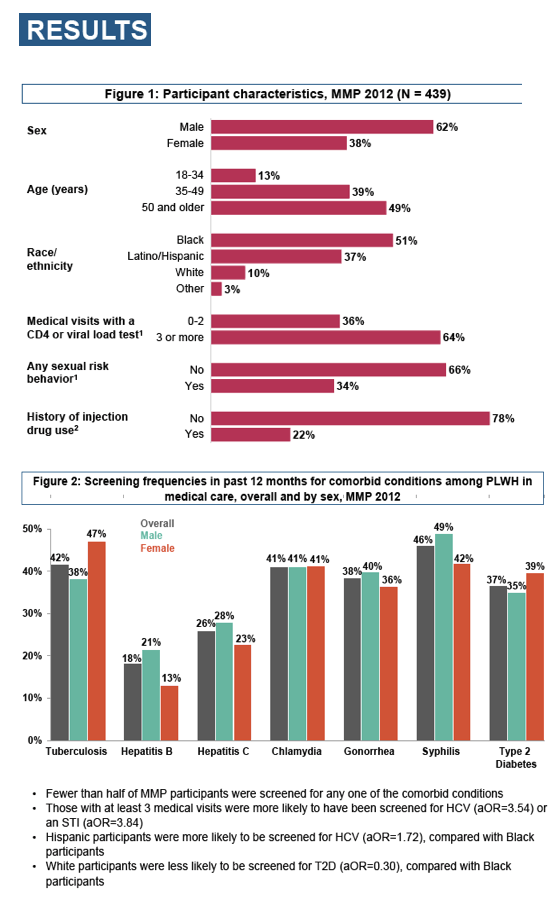
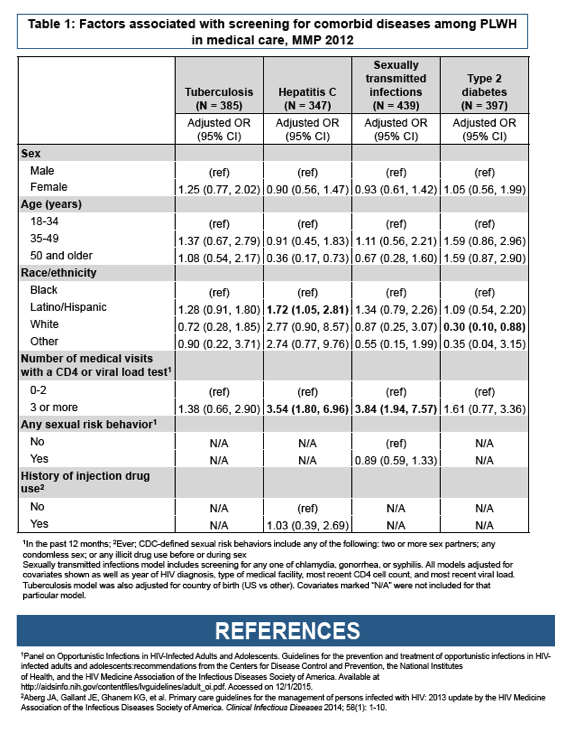
|
| |
|
 |
 |
|
|